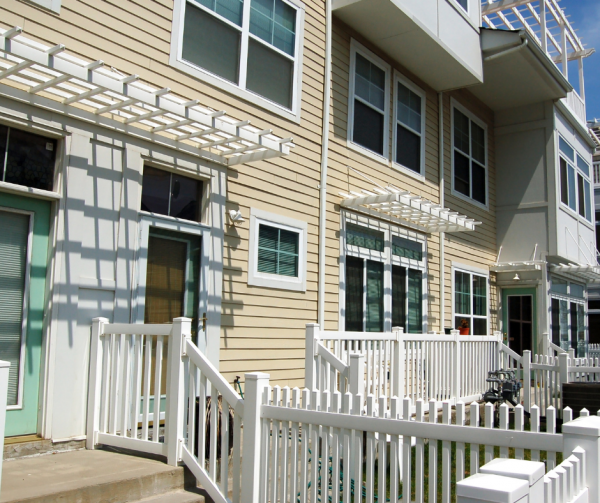As the cold of winter approaches, it’s crucial to ready your home’s exterior. This goes beyond aesthetics; it shields your property from potential damage. During colder months, your home becomes more vulnerable, highlighting the necessity for specific upgrades. Simple fixes like better insulation or sealing air leaks can keep your home warm, protect it from adverse weather, and even save you on energy costs.
In this guide, we’ll outline three critical exterior improvements necessary for winter. These insights empower informed decisions to fortify your home’s resilience.
Seal Any Leaks
When preparing your home for colder weather, one crucial task is to find and seal those sneaky gaps inviting chilly drafts indoors. Start your inspection by thoroughly checking windows, doors, and electrical outlets. These are common spots where cold air can seep in, affecting your home’s warmth.
Weatherstripping or caulking in these areas can make a significant difference, ensuring your home stays snug as the temperature drops. Don’t overlook less obvious areas like the attic and basement. Leaks here can lead to unpredictable indoor temperatures. You create a robust defense against the unnoticed cold by addressing these gaps and bolstering insulation.
Now, let’s talk about upgrading windows and doors. Older versions may have charm but might not retain heat effectively. Switching to modern models with multiple glass layers and advanced insulation can improve your home’s warmth. Brands like Andersen and Milgard offer various options for areas enduring harsh winters.
Remember, these adjustments aren’t merely about immediate comfort; they’re about securing your home’s long-term well-being against the winter cold.
Upgrade Your Siding
Another essential aspect of preparing your home for winter is assessing the condition of your siding. Siding acts as a protective shield for your home, shielding it from the elements all year round. However, as winter nears, the siding encounters added strain due to temperature fluctuations and harsh weather. Check your siding carefully for signs of damage from past seasons, like cracks or wear.
Weathered or damaged siding can compromise your home’s insulation, allowing heat to escape and chilly air to seep in, resulting in higher energy expenses and potential structural issues.
Consider investing in resilient and weather-resistant siding materials. Choices like vinyl, fiber cement, or engineered wood siding are renowned for their durability and ability to withstand various weather conditions, including the challenges posed by winter. They offer enhanced insulation and superior moisture protection and demand relatively minimal upkeep.
Furthermore, upgrading your siding boosts your home’s resilience to winter weather and enhances its visual appeal. Fresh siding can rejuvenate your home’s look, improving its curb appeal and value.
When considering a siding upgrade, getting advice from professionals or reliable contractors is a good idea. They can help you choose a suitable material and style that fits your home’s design and the local weather.
Fixing or Upgrading Your Roof
Your roof acts as a frontline protector against winter’s harsh elements.
Before the cold season, look at your roof for any signs of wear and tear. Look for clues like missing shingles, cracks, or spots that might allow water to seep inside.
Resolving these issues quickly is crucial. Even minor problems can escalate during winter storms, potentially leading to significant damage such as water leaks or ice buildup.
Consider hiring a professional roofing expert to conduct a thorough inspection and handle necessary repairs. Sometimes, a quick fix like replacing damaged shingles or sealing gaps can prevent more extensive damage and help fortify your roof against winter’s challenges.
If your roof is older or has weathered severe conditions, upgrading to sturdier materials could be a wise choice. Materials such as durable asphalt shingles, metal roofing, or resilient synthetic tiles offer enhanced resilience against the harsh winter weather.
Proper roof insulation not only aids in regulating indoor temperatures but also serves as a crucial defense against ice dams. Maintaining a consistently cold roof surface is essential in preventing the formation of ice dams. Adequate insulation helps regulate the roof temperature, reducing the risk of uneven heating and contributing to ice dam formation during winter.
Ensuring your roof has sufficient insulation helps maintain comfortable indoor temperatures and prevents potential issues caused by ice dams.
Conclusion
Preparing your home’s exterior for winter through key improvements is not just about fortifying against the cold—it’s a proactive investment in your property’s safety, efficiency, and longevity. Sealing leaks, upgrading siding, and maintaining the roof are pivotal steps toward ensuring a cozy, resilient, and visually appealing home during the harsh winter months.
Don’t wait until the harsh weather takes a toll on your home. Contact Phoenix Siding today to schedule a consultation and take the first step in safeguarding your home for the winter. Let us help you enhance your home’s exterior with our expertise and high-quality siding options. Act now to ensure your home is prepared to face the winter months confidently.



